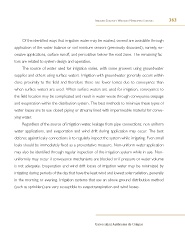Page 363 - FRUTAS DEL TRÓPICO
P. 363
363
iRRigating efficiently: wateRshed management stRategies
Of the identified ways that irrigation water may be wasted, several are avoidable through
application of the water balance or soil moisture sensors (previously discussed); namely, ex-
cessive applications, surface runoff, and percolation below the root zone. The remaining fac-
tors are related to system design and operation.
The source of water used for irrigation varies, with some growers using groundwater
supplies and others using surface waters. Irrigation with groundwater generally occurs within
close proximity to the field and therefore there are fewer losses due to conveyance than
when surface waters are used. When surface waters are used for irrigation, conveyance to
the field location may be complicated and result in water waste through conveyance seepage
and evaporation within the distribution system. The best methods to minimize these types of
water losses are to use closed piping or streams lined with impermeable material for conve-
ying water.
Regardless of the source of irrigation water, leakage from pipe connections, non-uniform
water applications, and evaporation and wind drift during application may occur. The best
defense against leaky connections is to regularly inspect the system while irrigating. Even small
leaks should be immediately fixed as a preventative measure. Non-uniform water application
may also be identified through regular inspection of the irrigation system while in use. Non-
uniformity may occur if conveyance mechanisms are blocked or if pressure or water volume
is not adequate. Evaporation and wind drift losses of irrigation water may be minimized by
irrigating during periods of the day that have the least wind and lowest solar radiation, generally
in the morning or evening. Irrigation systems that use an above ground distribution method
(such as sprinklers) are very susceptible to evapotranspiration and wind losses.
Universidad Autónoma de Chiapas

